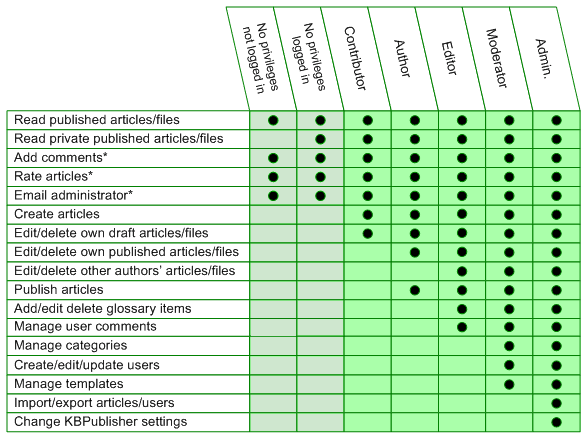|
Article ID: 210
Last updated: 29 Apr, 2016
We often get asked how licensing works with respect to users and why we say you can have as many readers as you like. PrivilegesKBPublisher licenses are based around privileges. There are five default privilege groups -- contributor, author, editor, moderator and administrator, and these are users who are licensed. But there is also another group of users who can access your knowledgebase. These users have no privileges. These are the first two groups of users in the chart below. These users can't edit articles or files. They have no privileges. (If you are a staff user with the appropriate access and could see the user details for these people you would see that Privilege field on the user screen is set to '__'.) These people can, however, read articles, rate them and add comments if they wish. They can also use the Ask a Question facility to send emails to your knowledgebase administrators. Thus, when calculating what type of license you require for KBPublisher, you only need to consider those users for whom you will assign privileges. In the diagram above, that is those users in the last five columns. RolesDoes a user have to be assigned a privilege before you can assign them to a role? No. ExampleWidget Inc. sells widgets. They use a knowledgebase to provide help and support for their customers. That same knowledgebase provides support information for internal users. Internal users see the same information that external users (the companies who buy the widgets) see, but they also have access to extra articles about troubleshooting, product returns, sales and so on. The company has 100 employees, and 20 customers. Each customer (to make our sums easier) has 10 people who use the knowledgebase, making a total of 200 customer users. That's 300 people in total who view the knowledgebase. The readers of the database can be divided into the following three groups:
These are the reader users. Users who fall into these groups will be assigned roles, but no privileges. They have no impact on licensing. You control what these people see through roles. Ten people manage the knowledgebase. These are:
These ten people will be assigned privileges and may or may not also be assigned roles. These are the ones who must be licensed. What KBPublisher license does Widget Inc. use? They require ten 'users', so they can start with a 10 License Pack. If Widget Inc. finds that their knowledgebase is so successful that they need to have more staff users (say 25), they can upgrade to the 30 License Pack simply by paying the difference between licenses.
Article ID: 210
Last updated: 29 Apr, 2016
Revision: 5
Access:
Public
Views: 35835
Comments: 0
External links
|
Powered by KBPublisher (Knowledge base software)


